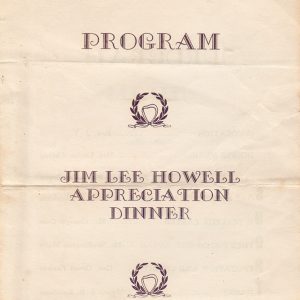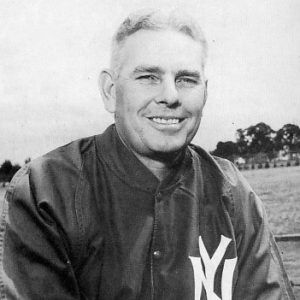calsfoundation@cals.org
James (Jim) Lee Howell (1914–1995)
James (Jim) Lee Howell was a professional football player and coach. As head coach of the New York Giants in the National Football League (NFL) from 1954 to 1960, he led the team to appearances in three NFL championship games and won the NFL title in 1956. He retired with a career record of 55–29–4. His career winning percentage is the best in Giants history for head coaches with fifty or more games and is among the best in NFL history. According to All-Pro defensive tackle Roosevelt “Rosey” Grier, Howell was “one of the greatest coaches to ever coach in the NFL.”
Jim Lee Howell was born in Lonoke (Lonoke County) on September 27, 1914, the third of four siblings. His parents were Hubert and Myrtle Howell. His father was a farmer and merchant. Howell attended the University of Arkansas in Fayetteville from 1933 to 1937, where he played basketball and football. Howell received All-Southwest Conference honors and lettered in both sports. In 1936, he succeeded future Arkansas governor Sidney McMath as student body president. He graduated with a bachelor’s degree in mathematics and later earned a master’s degree in education administration.
Howell began his professional football career with the Giants in 1937 as a defensive end and offensive end. He played in four NFL championship games with the Giants. In 1938, the team won the NFL title.
Howell enlisted in the U.S. Marine Corps on December 15, 1942. He served mostly stateside during World War II as a drill instructor, but he was involved in intense combat in the Pacific toward the end of the war. He resumed his career with the Giants in 1946 and played two more seasons before retiring after the 1948 season. He was an assistant coach with the team until 1954, when he became head coach.
Moonlighting was common among NFL coaches and players in the 1940s and 1950s; Howell operated his Lonoke County farm in the off seasons. He was an assistant football coach for Manhattan College in 1940, the same year he was elected to his only term (1941–1942) in the Arkansas House of Representatives. He briefly attended the University of Arkansas School of Law before going back to sports, becoming head coach for Wagner College in 1947. There, he began rebuilding a football program that had been discontinued during the war. In seven years, he compiled an unexceptional 24–30–3 record; however, his career winning percentage stood for several years as the best in school history. His best season was 1949 when the team finished 7–1–1, also the best in school history up to that date.
Despite a long and successful career, the Giants fired head coach Steve Owen following the team’s 3–9 collapse in 1953. Howell, a dark-horse candidate for the job, was selected as his successor, and he reluctantly accepted the offer to succeed Owen on the condition that his coaching staff would include what are now known as defensive and offensive coordinators. This was an unusual stipulation for the era, especially for a young, unproven head coach with questionable credentials. Howell selected Giants player Tom Landry to run the defense and accepted Giants ownership’s recommendation of Army assistant coach Vince Lombardi to run the offense.
The Giants rebounded to 7–5 in 1954. In 1955, the team continued to improve, but its record fell to 6–5–1. In 1956, the team won the Eastern Conference with an 8–3–1 record and routed the Chicago Bears 47–7 in the 1956 NFL championship game, winning the Giants’ first NFL title since 1938. The 1957 team stumbled to 7–5 and missed the playoffs. The 1958 and 1959 teams—9–3 and 10–2, respectively—won Eastern Conference titles, but lost to the Baltimore Colts in consecutive NFL championship games. The 1958 game, the first NFL championship game to be decided in “sudden-death” overtime, is known as “The Greatest Game Ever Played” because of its dramatic finish and its decisive contribution to the NFL’s emerging popularity as a spectator sport.
Howell announced after the 1959 season that he would retire at the end of the 1960 season. Lombardi had already left to coach the Green Bay Packers, and Landry was returning to Texas to become the first head coach of the Dallas Cowboys. In spite of the defections, the team finished the season with a respectable 6–4–2 record. Howell’s successor, Allie Sherman, led the team that Howell built to three consecutive NFL championship games in 1961–1963, but the Giants would not win another NFL title until their victory in Super Bowl XXI following the 1986 season. From 1961 to 1979, Howell served as director of player personnel for the Giants and then as a team consultant and scout until he retired from professional football in 1986.
The Giants’ success during the 1950s has been attributed mostly to the two extraordinary assistants whose careers Howell mentored, both of whom became legendary NFL head coaches. Howell’s own legacy has been compromised by his protégés’ renown, his laissez-faire management style, and a humble demeanor. However, based on his record, he was one of the most successful head coaches of the 1950s, surpassed only by Pro Football Hall of Famers Paul Brown, who won more games, and Wilbur “Weeb” Ewbank, who defeated Howell’s teams twice in NFL championship games.
Howell has detractors, notably Giants stars Frank Gifford and Sam Huff. However, according to Vince Lombardi Jr., Howell’s leadership is misunderstood and underestimated. Referencing Howell’s self-effacing and frequently cited remark that all he did as Giants head coach was inflate the footballs, Lombardi wrote: “This was an exaggeration….Howell was very much in charge of that team. [He] rode herd on his assistants Vince Lombardi and Tom Landry.” Sportswriter Jack Cavanaugh concurred: “As brilliant and creative as Landry and Lombardi were, Howell ran the overall show….He knew how to run an organization.” Another Giants great, Pat Summerall, added: “Jim Lee was the glue who held the team together.”
Howell was inducted into the Arkansas Sports Hall of Fame in 1959, the University of Arkansas Sports Hall of Honor in 1990, and the New York Giants’ Ring of Honor in 2010.
Howell died on January 4, 1995, in Lonoke following a long illness. He was survived by his wife, Susan, and four children. His remains are interred in Lonoke Cemetery.
For additional information:
Cavanaugh, Jack. Giants Among Men: How Robustelli, Huff, Gifford, and the Giants Made New York a Football Town and Changed the NFL. New York: Random House, 2008.
Maraniss, David. When Pride Still Mattered: Lombardi. New York: Simon and Schuster, 1999.
Maxymuk, John. NFL Head Coaches: A Biographical Dictionary, 1920–2011. Jefferson, NC: McFarland & Company, 2012.
Thomas, Robert M. “Jim Lee Howell, Ex-Giants Coach, Dies at 80.” New York Times, January 6, 1995. http://www.nytimes.com/1995/01/06/obituaries/jim-lee-howell-ex-giants-coach-dies-at-80.html (accessed October 13, 2021).
Greg A. Phelps
Lindsey Wilson College
 World War II through the Faubus Era, 1941 through 1967
World War II through the Faubus Era, 1941 through 1967 Howell Appreciation Dinner Program
Howell Appreciation Dinner Program  Jim Howell
Jim Howell 



Comments
No comments on this entry yet.